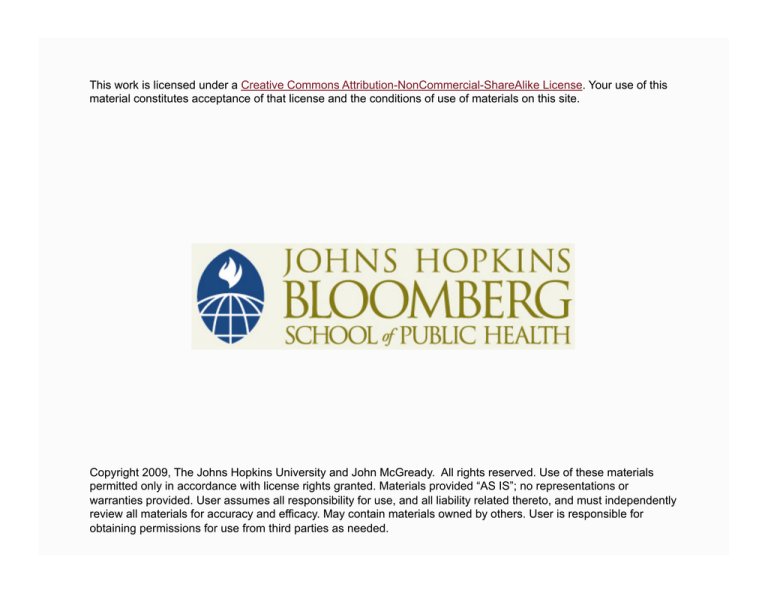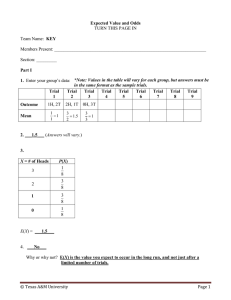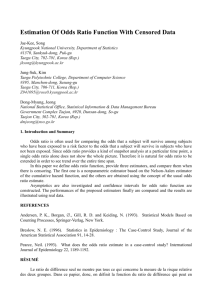
This work is licensed under a Creative Commons Attribution-NonCommercial-ShareAlike License. Your use of this
material constitutes acceptance of that license and the conditions of use of materials on this site.
Copyright 2009, The Johns Hopkins University and John McGready. All rights reserved. Use of these materials
permitted only in accordance with license rights granted. Materials provided “AS IS”; no representations or
warranties provided. User assumes all responsibility for use, and all liability related thereto, and must independently
review all materials for accuracy and efficacy. May contain materials owned by others. User is responsible for
obtaining permissions for use from third parties as needed.
Section D
Another Non-Randomized Study Design: The Case-Control
Design
Case-Control Study
Researchers were interested in studying the association between
alcohol consumption and esophageal cancer
Esophageal cancer is a rare condition—a prospective study would
require a huge number of subjects
Another approach—choose subjects whose cancer status is known at
the time of recruitment into the study
- In this scenario, researchers chose 200 cases and 775 controls
and asked about alcohol consumption
3
Case-Control Study
Study results: case/control status by alcohol consumption per day
> 80 gm/day ≤ 80 gm/day
Totals
Case
96
104
200
Control
109
666
775
Totals
205
770
975
4
Alcohol/Esophageal Cancer
Important questions
- Can we estimate the prevalence of esophageal cancer based on
the results for this study?
- Can we calculate the probability of cancer if you drink more
than 80 grams of alcohol per day using this case-control study?
- Can we compute the relative risk of cancer for those who drink
> 80 grams of alcohol per day as compared to those who drink
≤ 80 grams per day?
5
Important Caveat in Case-Control Studies
In case-control studies, the individuals with the disease (the cases)
have been over-sampled
The percentage of subjects in your study who have disease are
greater than in the population: hence the prevalence/risk in the
sample is an overestimate of actual prevalence/risk, usually by a
large factor
“Prevalence” in the sample is a function of the design of the study:
in this example researchers set prevalence (risk) at . . .
6
Important Caveat in Case-Control Studies
The percentage of the population who have disease from a casecontrol study (i.e., the risk/prevalence of disease) cannot be
correctly estimated from a case-control study
Hence, you cannot estimate relative risk (RR) relating disease to
exposure of interest
CANNOT compute relative risk from case-control study
CAN compute odds ratio from case-control study
7
Odds Ratios in Case-Control Studies
Recall, the estimated odds ratio of an outcome compares the
observed odds of the outcome for two groups of individuals and is a
function of the risk for each group
8
Case-Control Study
Quick approach to computing odds ratio from a 2x2 table:
diagonal cross products!
> 80 gm/day ≤ 80 gm/day
Totals
Case
96
104
200
Control
109
666
775
Totals
205
770
975
9
Alcohol and Esophageal Cancer
Interpretation
- Individuals with high alcohol consumption (> 80 grams/day) are
over five times the odds of esophageal cancer compared to
individuals with low alcohol consumption
10
Important Caveat in Case-Control Studies
The odds ratio is very close to what the relative risk would be if you
had performed a cohort study (provided the disease was rare,
say < 1/100)
If the disease is not rare, OR still follows same direction as RR, but
may not be a very accurate estimate of RR
11
Odds Ratios
In the alcohol-esophageal cancer example, 5.64 is an estimate of
the odds ratio based on a limited sample of data
It is not the population parameter odds ratio
Confidence intervals can be calculated that give the range of
plausible values for the population odds ratio
If the 95% confidence interval for the odds ratio does not include
one, it suggests that there is a significant association (p < .05)
12
Odds Ratios
How can you test if the population odds ratio is one or not?
- Fisher’s exact test
- Chi- square test (approximation)
13
Using Stata
“cci” command syntax—same setup as “csi” command that we saw
in SR1
- cci a b c d
Where a, b, c, d from appropriate 2x2 table:
Exposure
Yes
No
Yes
a
b
a+b
No
c
d
c+d
a+c
b+d
Outcome
14
Using Stata
Alcohol/esophageal cancer example
- cci 96 105 109 666
Recall the 2x2 table:
Exposure
Yes
No
Yes
96
104
200
No
109
666
775
205
770
Outcome
15
Using Stata
Results from Stata
16
Using Stata
Results from Stata
17
Using Stata
Results from Stata
18
Using Stata
The 95% CI for the OR of esophageal cancer for those consuming
> 80 grams of alcohol per day compared to those consuming 80
grams or less is 4.0 to 8.0
19
Odds Ratio and Case-Control Studies
Why would we even bother calculating the odds ratio when we can
calculate relative risk?
- The odds ratio turns out to be important because you can
calculate it either in cohort studies or case-control studies
- The relative risk can only be calculated from cohort studies
Luckily, as we saw in SR1, the odds ratio informs us about risk
If the outcome of interest is rare overall then the odds ratio is a
good estimate for the relative risk
20
Odds Ratio and Case-Control Studies
Recall:
All three hypotheses testing for disease exposure relationship
21
Lecture Evaluation
Please take a moment to evaluate this
lecture. Your feedback is very important
and will be used for future revisions. The
Evaluation link is available on the lecture
page.
22







